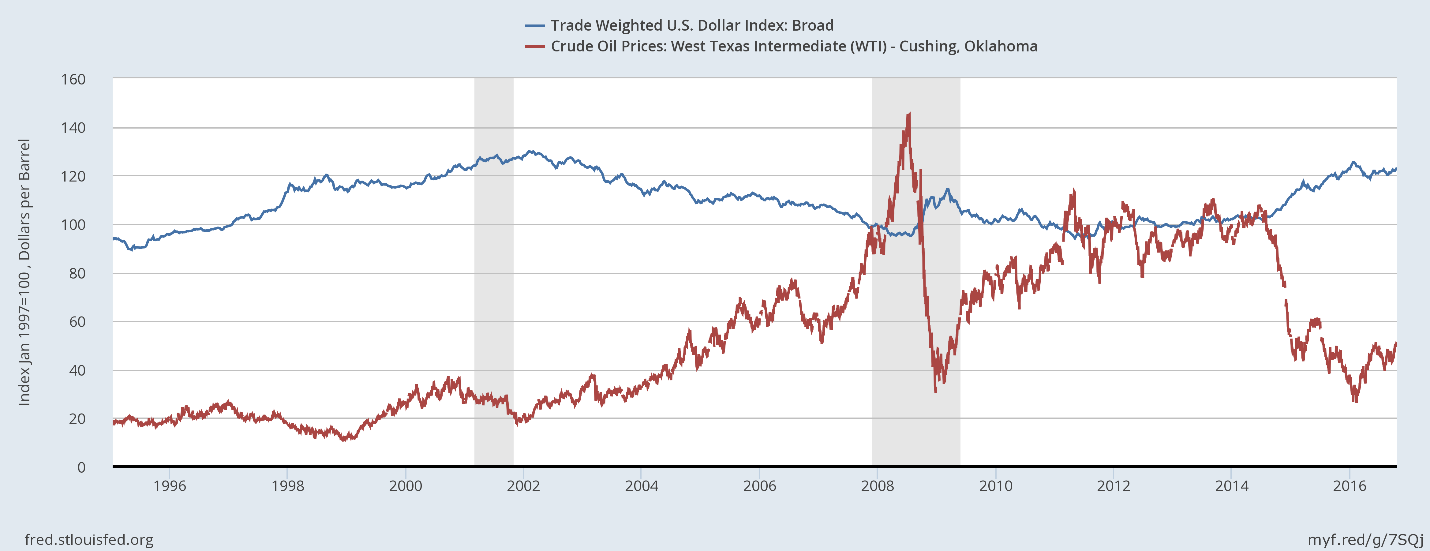
Oil prices and the dollar have been highly negatively correlated during the oil price collapse. From June 2014 through September 2016, the correlation has been -95%.
In financial articles, it's a commonplace to read that oil prices fell because the dollar strengthened, or oil prices rose because the dollar weakened. This is largely a confusion of correlation with causality.
It is true that there is a linkage. A stronger dollar does render oil prices higher in foreign currencies, thereby adversely affecting demand, a negative factor for oil prices.
But worldwide oil demand is highly inelastic (non-responsive) over the course of even one year. For example, in 2015, world oil consumption averaged 94.3 million barrels per day, 1.6% higher than in 2014. However, crude oil prices (WTI) averaged $48.69/b in 2016, 48% lower than in 2015. That is a very muted effect.
Classical economics explains how exchange rates are determined by the interconnections among interest rates, inflation, the economy, balance of payments and expectations. Oil prices factor into that equation. They are sometimes a big factor and at other times not.
Empirical Evidence
I performed analyses over varying timeframes to test how robust the relationship of the dollar is to oil, as well as to test whether the dollar was leading oil prices.
Oil prices peaked in June 2014, and so I analyzed the period from that month through September 2016. As mentioned above, the correlation was -95% for coincident (same month) values. However, the correlation rose a bit (-96%) when I tested oil as a one-month leading indicator of the dollar, and the correlation dropped a bit (-92%) when I tested the dollar as a leading indicator for oil.
In addition, the standard deviation of the oil price, a measure of volatility, was three times as high for oil as that of the dollar. This is not consistent with the theory that the dollar is determining oil prices. If it were, why would oil be so much more volatile than the dollar?

Source: Board of Governors of the Federal Reserve System (US).
Release: H.10 Foreign Exchange Rates
In a second test, I looked back a longer period, ten years. That period included the financial crisis of 2008/09. As can be seen in the graph above, the oil price spike and collapse was many times the amplitude of the change in the dollar. In these tests, the correlation of the coincident values (-87%) was the same as for oil lagging the dollar by a month. The standard deviation of oil prices was again three times the size of the dollar.
Finally, I tested the long-term relationship going back to 1990. Over that 26+ year period, there was almost no correlation (2%). Lagging oil to the dollar by one month made no difference. The standard deviation of oil was twice that of the dollar.
Conclusions
Exchange rates are determined by a host of factors, and oil is just one of them. The U.S. dollar benefited from lower oil prices, but it didn't cause them. Because the U.S. is a net oil importer, and oil is sold in dollars, the U.S. balance of trade improved and inflation was reduced. These are positive factors supporting the dollar.
Contrary to popular belief, the dollar does not make oil prices go up or down. If anything, oil prices lead the dollar, not vice-versa.
Check back to see my next post!
Best,
Robert Boslego
INO.com Contributor - Energies
Disclosure: This contributor does not own any stocks mentioned in this article. This article is the opinion of the contributor themselves. The above is a matter of opinion provided for general information purposes only and is not intended as investment advice. This contributor is not receiving compensation (other than from INO.com) for their opinion.

excellent analysis!